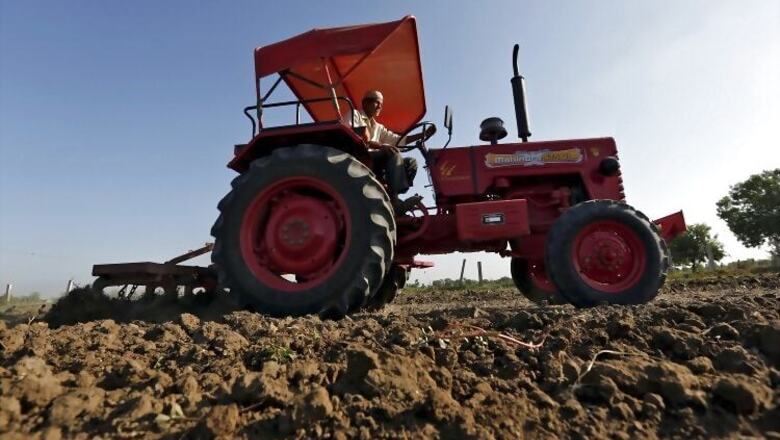
views
The general perception is that nearly 70% of Indians live in rural areas and they have to share a 15% sliver of GDP, labour for agricultural operation is available for the asking. But the latest national survey shows that only 40% of the country’s 156 million households live mainly off agriculture, and even they depend on other sources for 40% of their incomes. Go to any village and one hears farmers complain of labour shortage. The demand for farm labour tends to get bunched up during sowing and harvesting. This is the reason that mechanisation is catching up, though the pace of the last decade might get arrested because of slowing wage rate growth due to depressed commodity prices.
At a field in Kagal in Maharashtra’s Kolhapur district, a mowing machine looks terrifying in aspect and singular in purpose. Like a hurricane it brooks no opposition. Blades an inch below the ground neatly cut the cane. Other mechanisms chop the cane after separating it from trash, which is spat on to the ground, to enrich the soil. In two hours the harvester would have done an acre, a job which would have taken 10 workers about four days. At Rs 265 a tonne workers are cheaper to engage; but they are hard to find and harder to please. Machine cutting costs more at Rs 300 a tonne, but the sugar recovery is higher because no stubs are left behind. As factories pay for cutting and transportation; farmers prefer machines.
Cane harvester hirer in Kagal village of Kohlapur district Vinayak Vilasrao Patil says the response has been good.
The machine costs Rs 1.25 crore and has been financed mainly with a bank loan, with the local sugar factory guaranteeing business in its catchment area on the basis of a tender awarded to the one who offered to charge the lowest rate. It is expected to take longer than 12 years to recover the cost because this is small holder country, where field sizes do not allow the machine to move easily. Even if most farmers want to make the switch, they cannot.
Swapnil Shah, cane grower in Kagal, says, “Only 50% of farmers have shifted because the rest do not have access. Their fields are also soggy and this machine can work only in a dry field.”
Farm mechanization got a boost in the last decade from high economic growth, and the global commodities boom. Plentiful work in the construction sector and the MNREGA rural jobs scheme has pulled workers out of agriculture.
While the country’s total workforce increased by 10 million between 2005 and 2011, those engaged in agriculture fell by 31 million. The share of agricultural workers in the total workforce slipped from 57% to 49%. In the latest national sample survey, agricultural households cited labour as significant component of monthly crop production costs, accounting for 21% of the total, next only to fertilizer.
Tractors sales also got a boost. Annual sales doubled from nearly 2,50,000 to over 5 lakh and touched a peak of nearly 6.5 lakh in 2013-14. They have declined of late with the economy flagging and commodity prices softening. But while the pace of mechanisation has slowed down, it will not reverse.
Agricultural economist Ashok Gulati says, “We are debating whether this is going to last. We will have to wait for one year before a turning around can come. Mechanizatiion will slow down. State must move in. Capital subsidy is being given.”
Mechanisation mostly meant tractors. Punjab leads in this respect and, according to an expert, it has one for every 10 hectares. They do not sweat enough to justify the cost running just 350 hours a years when they should be doing 1000 hours to justify the investment. What is needed is useful mechanisation. Cotton picking is waiting for affordable machines and so is sugarcane harvesting.
Agriculture in Punjab on the current scale is impossible without machines, even if workers were available and farmers were willing to pay more. In Punjab wheat is grown on 84% of the total cultivated area of 4.2 million hectares. Paddy covers 68% of the cultivated land. It has to be harvested during a three week window, failing which the subsequent wheat crop will miss the period in March and April, when the temperature is ideal for the grains to bulk up, before the heat sets in.
Ranjit Singh, a combine owner in Bagga Khord in Ludhiana says there is much competition and he can operate his combine for two months a year.
Another farmer Gurcharn Singh Malli of Nurpur Bet in Ludhiana claims he pays Rs 1,100 an acre to harvest 13 acres. He would have to pay Rs 5,000 to harvest an acre manually.
Nurpur Bet is a village on the outskirts of Ludhiana. It has a grain mandi where farmers hang around, some of them for a week, waiting for the state government to procure wheat. Better known is a cooperative by that name, which is described by an academic as a case study. It owns machines worth half a crore rupees and rents them out at affordable rates.
The cooperative’s fuel pump is a big draw with its 743 members who have 4,000 acres between them across six villages. They trust it for unadulterated diesel and correct measurement. A news report says Ludhiana has 363 cooperatives, but Nurpur Bet is one of the few in the state that makes a profit. Private rental companies also have huge fleets of machines and are thriving, given the highly mechanized nature of agriculture in the state.
“Wheat is 100% mechanized. In rice, transplanting is done manually for the major part but harvesting is mechanized. We have transplanters but if we compare with labour cost, it is not cheaper,” says Jaskarn Singh Mahal, Dean at College of Agricultural Engineering, Punjab Agricultural University, Ludhiana.
At an agriculture university in Maharashtra’s Parbani district, state government officials have been invited for a demonstration of mechanized cotton sowing and picking. Because of a shortage of labour, farmers are unable to sow early in the monsoon season. Those that fail to catch the first showers wait for the next. The sowing season extends from 15th June all the way to 25th July. As the intensity of rain increases, there is a greater chance of damage to saplings, with consequent impact on yields.
Cotton picking is also awaiting machines because getting labour is a production in itself, especially for later pickings, when there is not enough lint to pick unlike early on when workers charge by the kilogram and can make upwards of Rs 350 a day. In Punjab, it costs about Rs 6000 to pick an acre of cotton. For mechanical picking, both the rows and the plants have to be re-configured. The rows should be designed for machine movement. The plants are densely planted to compensate for fewer pickings. They must be of uniform height, flower at the same time and not be bushy.
“When we want to switch over to mechanization, it is not that the machines will come and do the operations the similar way. We have to change whole of the system, the varieties that are suitable for mechanization, the agronomy the row to row to space, the plants should be mature at one time, the whole system has to be tuned up to mechanization,” says Jaskarn Singh Mahal.
At the Borlaug Institute for South Asia (BISA) 500 acre campus in Ludhiana, agricultural machinery is arranged like in a military garrison. Pride of place belongs to the laser leveller which can create flat surfaces with as little as half an inch variation so water can spread quickly without stagnating. Sharing rank is the combine harvester with a device at the back to spread straw in the field and the direct seeder which can place rice, wheat, moong or any seed at the required depths and intervals rank high. The tractor has been knocked off its perch because under conservation agriculture which Bisa recommends for India, land cannot be tilled. Tilling leads to loss of moisture. It also destroys capillaries formed by roots which keep the soil soft. The tractor is just a vehicle for movement and a device for supply of motive power to attachments. The rotavator which can mill the earth to a powder is an outcast.
BISA’s Jabalpur farm has not much use for the laser leveller as the surfaces here are uneven, the soil black and clayey and sprinkler irrigation the norm unlike in the Indo Gangetic plain where fields are flooded. But both practice conservation agriculture, where previous crop residue is not burnt but left behind to conserve moisture, suppress weeds and nourish the soil. The crops are grown on raised beds to save water. Here paddy is being sown by parting the straw in dry and hot early May, as it is difficult to work the fields during monsoons, which are a month away. This kind of agriculture goes back to basics; but it is not primitive; it requires machines.
Raj Gupta, Bisa Head, says, “Conservation agriculture not possible without machines. Farmers are still doing conservation agriculture even with traditional drills and planters but they disturb the soil more. So we definitely require new machines.”
The Directorate of Weed Research at Jabalpur has made conservation agriculture its flagship programme for the past three years. It has held about a hundred demonstrations on farmers’ fields and has found the response very encouraging despite their initial apprehensions. The state has agreed to give 40% subsidy for seeders. By not having to wait for monsoons at end of June, and sowing rice in dry May itself, conservation agriculture is bringing large areas that remained fallow under cultivation. This form of agriculture requires expertise, experience and also the use of herbicides, besides machinery.
Ajit Ram Sharma, Director, Directorate of Weed Research, Jabalpur says, “Herbicides are very effective and unlike insecticides and fungicides do not have much residual effect. This kind of agriculture is not only machinery driven but also herbicide driven. Controlling weeds with herbicides is very simple and very cheap compared to conventional methods which farmers are adopting.”
One of the first converts to conservation agriculture in Jabalpur is Satish Dubey who has been practising it on the 35 acres of owned and leased land for the past three years. Farmers like him do not require persuasion, as they save money in field preparation even before the first seed is sown, which is about a fifth of the cost.
“When I used to do farming the traditional way, i would take a hit every year. I used to spend Rs 4,000 (an acre) in ploughing the field four times even before sowing. I used to use 80 kg of (wheat) seed (per acre).With ‘Happy’ direct seeder I use half the quantity. My wheat output has increased from 12-13 (quintals an acre) to 17-18 (quintals),” says Satish Dubey, a farmer at Bharda village in Jabalpur.
Ajay Sharma has 50 acres of his own and his large joint family own 10 times the area. This is the first time he is doing moong as a third crop. Normally, farmers like him do two crops in this part of the country, usually rice and wheat. The time saved from field preparation, has enabled Ajay to sow an opportunistic short duration crop of green gram, which is advocated under conservation agriculture as way to naturally enrich the soil with nitrogen. But a part of Ajay’s land is ploughed. Does it mean he is not fully convinced?
Ajay Sharma says, “No, from the cultivation of wheat itself (last year) I realised that the direct seeder was a good machine. So I sowed moong on a part of my land . But the reason why I am doing cultivation the usual way is because I am unlikely to get the machine this time, at least not for the time required to sow a large area.
Mithilesh Kumar Shukla has 13 acres and he has sown moong the traditional way on one and a half acres. When asked how he can wax about conservation agriculture when he has not done it himself, he says he is convinced by what he has seen. “From what I saw I feel this is a good method of farming. When bhaiyya (Ajay Sharma) sowed (with a direct seeder) I was there when he harvested i was there too. I feel that the yield he got, I can get too. This is a good system. We used to do wheat and rice. With this system we can do moong or urad too,” says Shukla.
In Punjab moong is grown in a standing field of wheat. It will be harvested just before the monsoons set in, and rice to be sown. Wheat in cotton, or moong after wheat followed by rice is the kind of sustainable intensification conservation agriculture makes possible with some of the new machines and practices. And this is not a fad. Punjab’s economic survey says in 2001 just 750 hectares was under zero-till agriculture in the state. Ten years later it had spread to 7.49 lakh ha or 18 percent of Punjab’s cultivated land. It is still a long way from Brazil, where it is practised on 32 million ha, in Argentina on 29 milliion ha, in the United States on 27 million ha and in Australia on 18 million hectares. Conservation agriculture, together with other crop technologies, could take us to the next green revolution.
Raj Gupta adds, “Conservation agriculture can lead into this if we sincerely fine tune our policies towards its promotion. They we can feed another India. That is my firm belief But if we continue with the same old rut, without addressing the fatigues and soil health problems there is no way we can sustain.”
Indian farmers do not need much convincing. But the cost of laser levellers, direct seeders and high horsepower tractors deters them. The government must step in with easy loans to spread the use of these machine and make the Punjabi saying: Dab ke waa aur raj ke khaa, plough hard and eat well, lapse into nostalgia.
(To know more, watch 'Smart Agriculture' presented by Monsanto, every Saturday & Sunday at 4:30 PM and Monday at 5:30 PM on CNN-IBN and every Saturday & Sunday at 4:30 PM on CNBC-Awaaz.)


















Comments
0 comment